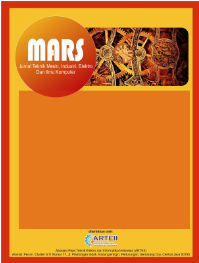Analisis Studi Literatur Pemanfaatan Medan Elektromagnetik pada Perangkat Navigasi dalam Kehidupan Sehari-hari
DOI:
https://doi.org/10.61132/mars.v2i6.529Keywords:
Electromagnetic Field, Electromagnetic Utilization, NavigationAbstract
This research discusses the utilization of electromagnetic fields in navigation devices, which play a crucial role in daily life. With technological advancements, navigation systems such as GPS, radar, and compasses have become essential tools for determining position and direction. This study employs a literature review method, which involves a series of activities related to collecting library data, reading, recording, and processing relevant information for the research objective. The aim is to analyze various sources of information regarding the use of electromagnetic fields in these devices. The findings indicate that electromagnetic fields enable navigation devices to function effectively, despite challenges such as signal interference and weather conditions that may reduce accuracy. This research aims to explore how electromagnetic fields, which combine electric and magnetic fields, are utilized in modern navigation systems. The method used is a literature review, where the researchers collect and analyze information from various reliable sources to understand the effectiveness and challenges in the application of electromagnetic fields in these devices. The results show that electromagnetic fields allow navigation devices to operate effectively, providing accurate location information
References
Antoro, D., Dewi Apriani, D., Akhsan, A., & Barombong, P. P. (2023). Optimalisasi alat radar dalam navigasi KM. Bintan Utama di alur pelayaran sempit. Jurnal Poltekpel Barombong. Retrieved from https://jurnal.poltekpelbarombong.ac.id
Anugrah, F. (2023). Sistem kontrol dan pengamanan kotak penyimpanan uang menggunakan aplikasi Telegram berbasis Arduino
Arino Bemi Sado. (2019). Pengaruh deklinasi magnetik pada kompas dan koordinat geografis bumi terhadap akurasi arah kiblat.
Dimas, D. P., & Firmansyah, B. (2023). Rancang bangun sistem GPS (Global Positioning System) untuk keamanan sepeda motor. Jurnal Nasional Informatika (JUNIF), 4(1), 1-5.
Elio Vica, M., Wijanto, H., & Wahyu, Y. (2017). Antena phased array untuk radar 3D S-band.
Hermawan, F., & Yuwono, R. (2017). Analisis pengaruh penambahan jumlah pemancar FM terhadap tegangan dan kuat medan elektromagnetik pada rectenna. Elektronika Dasar. Retrieved from http://elektronika-dasar.web.id
Listiana, R., Damayanti, E., Prasetyo, H., Amirullah, A., & Otomasi Industri, T. (2021). Rancang bangun koper pintar berbasis mikrokontroler. Jurnal Teknologi, 15(1).
Muhammad, D. R., Ali, E., & Pramudita, A. A. (2020). Perancangan filter bandpass combline 3 GHz pada sistem pemancar radar gelombang kontinu.
Rachmi, N., & Firman Husain, A. (2020). Analisis pengaruh penggunaan alat navigasi yang ada di Makassar bagi alur pelayarannya. SENSISTEK, 3(1).
Sains Riset, J., & Arisma Iswardani, F. (2023). Analisis studi literatur pemanfaatan gelombang elektromagnetik (ELF) bagi industri pertanian. Jurnal Sains Riset, 13(1), 15. https://doi.org/10.47647/jsr.v10i12
Snyder, H. (2019). Literature review as a research methodology: An overview and guidelines. Journal of Business Research, 104, 333–339. https://doi.org/10.1016/j.jbusres.2019.07.039
Sumardi, A., (2020). Implementasi wireless sensor network (WSN) guna mengetahui koordinat pasukan dalam penugasan daerah rawan di perbatasan.
Tawab, I., Sumajudin, B., & Ryanu, H. H. (2021). Implementation of patient respiration monitoring using FMCW radar with software defined radio. 8(5).
Uguy, R., & Pangalila, L. (2022). Evaluasi pengukuran topografi pada proyek jalan Manado Outer Ringroad III. Jurnal Ilmiah Realtech, 18(1), 25-31.
Yudhanto, T. H., Fayakun, K., & Alim, E. S. (2021). Purwarupa GPS (Global Positioning System) Tracker Online. Jurnal Teknologi Informasi dan Komputer, 3(1), 31-38.
Downloads
Published
How to Cite
Issue
Section
License
Copyright (c) 2024 Mars : Jurnal Teknik Mesin, Industri, Elektro Dan Ilmu Komputer

This work is licensed under a Creative Commons Attribution-ShareAlike 4.0 International License.





